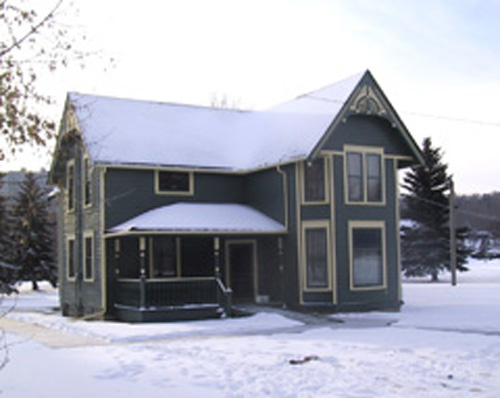Other Name(s)
JOHN WALTER HISTORIC AREA
J. Walter House
Walter House
Links and documents
n/a
Construction Date(s)
1875/01/01 to 1901/01/01
Listed on the Canadian Register:
2008/03/25
 Statement of Significance
Statement of Significance
Description of Historic Place
The John Walter Historic Area comprises three residences situated on roughly 46 hectares of land on the south side of the North Saskatchewan River in Edmonton's River Valley Walterdale district. The earliest two buildings date from 1875 and 1884 and are both one and one-half storey log cabins composed of squared horizontal logs with dovetail joints. The 1901 House is a large, balloon-framed house of milled lumber featuring prominent gable end trims. The John Walter Historic Area is owned and operated as an interpretive site by the City of Edmonton.
Heritage Value
The heritage value of the John Walter Historic Area lies in its association with early Edmonton entrepreneur and prominent civic figure, John Walter.
Born in the Orkney Islands, Scotland, in 1849, John Walter immigrated to Canada in 1870 to work as a boat builder with the Hudson's Bay Company at Fort Edmonton. At the conclusion of his five year work term, Walter left the company's employ to found a homestead on the south bank of the North Saskatchewan River. The home he built on this site in 1875 was the first residence constructed across the river from Fort Edmonton in what became the community of South Edmonton (later renamed Strathcona). An entrepreneurial, ambitious man, Walter quickly established himself as one of the settlement's pre-eminent entrepreneurs and civic contributors. His business endeavours included a general store, boat construction business, lumber mill, blacksmithing operation, ferry service, steamboat freight and passenger line, and a coal mine. Walter's first home served as an office for the various branches of his nascent commercial empire; it also housed Edmonton's first telegraph office and served as an armed observation post for federal forces during the North-West Rebellion in 1885. A thriving industrial and residential neighbourhood grew up around Walter's homestead and was named in his honour - Walterdale. As a result of success in his many and varied enterprises, Walter became the community's first millionaire. His importance, however, extended beyond the business realm. He was also a major participant in community affairs, serving as the Chairman of the first South Edmonton School Board, sitting on the first Strathcona Town Council, spearheaded efforts to amalgamate Edmonton and Strathcona, and contributing land and money for recreational facilities and hospitals. Walter's ambition, energy, and business savvy were indispensable in the development of Edmonton from an isolated fur trade post to an emergent western Canadian metropolis.
The three buildings extant on site represent an evolution in the personal and professional life of Walter and his family. The 1875 home features simple linear-planed horizontal log construction with dove-tail joints. It is the oldest surviving house on Edmonton's south side. The second home, built in 1884, is similar in construction and design to the original house, although somewhat larger - a sign of Walter's early successes and perhaps also of his desire to expand his space in preparation for his marriage in 1886. The 1901 house represents a departure from the two earlier residences. This home features balloon-framing and is far more ornate than its predecessors, boasting a number of elements like gable end trims that appealed to the aesthetic sensibilities of well-to-do late Victorian Canadians. It was one of the largest homes in the Edmonton area at the time and one of the first supplied with electricity. These three structures are virtually all that remains of the once vital early Edmonton district of Walterdale.
Source: Alberta Culture and Community Spirit, Historic Resources Management Branch (File: Des. 1719)
Character-Defining Elements
The character-defining elements of the John Walter Historic Area include such features as:
1875 House:
- mass, form, and scale;
- squared horizontal log construction with dovetail joints;
- cedar-shingled, medium-pitch front gable roof;
- cedar shingling in gable ends;
- fenestration pattern;
- arrangement and style of doors, including original south elevation door and slightly later east and north doors;
- floorplan;
- exposed logs on main floor interior and rough-milled lumber on the second floor;
- interior hardware.
1884 House:
- mass, form, and scale;
- squared horizontal log construction with dovetail joints;
- cedar-shingled gable roof;
- fenestration pattern;
- arrangement and stlye of doors and associated hardware;
- floorplan;
- vertical tongue and groove interior panelling on the main floor and rough-milled lumber on the second floor;
- plank flooring.
1901 House:
- mass, form, and scale;
- gable roof with cross gables;
- gable end trims;
- fenestration pattern and style;
- front porch;
- original registers.
 Recognition
Recognition
Jurisdiction
Alberta
Recognition Authority
Province of Alberta
Recognition Statute
Historical Resources Act
Recognition Type
Provincial Historic Resource
Recognition Date
1996/03/08
 Historical Information
Historical Information
Significant Date(s)
n/a
Theme - Category and Type
- Developing Economies
- Extraction and Production
- Peopling the Land
- Settlement
Function - Category and Type
Current
- Leisure
- Historic or Interpretive Site
Historic
- Residence
- Single Dwelling
Architect / Designer
n/a
Builder
n/a
 Additional Information
Additional Information
Location of Supporting Documentation
Alberta Culture and Community Spirit, Historic Resources Management Branch, Old St. Stephen's College, 8820 - 112 Street, Edmonton, AB T6G 2P8 (File: Des. 1719)
Cross-Reference to Collection
Fed/Prov/Terr Identifier
4665-0441
Status
Published
Related Places

JOHN WALTER MUSEUM AND HISTORICAL AREA
The John Walter Museum and Historical Area sits on a landscaped park west of the south entrance to the Walterdale Bridge, on the south bank of the North Saskatchewan River. The…